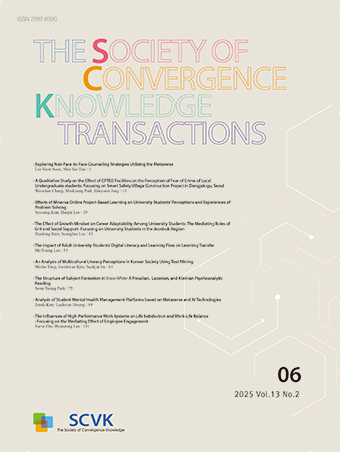Research Article
Abstract
References
Information
본 연구에서는 수치해석을 통해 부식결함에 따른 열수송관의 건전성 평가를 수행하였다. 유한요소기법을 이용하여 수치모형을 구축하였고, 기존 실험데이터와 비교하여 검증하였다. 수치모형을 통해 열수송관의 크기, 부식결함의 형상 및 크기에 따라 총 80개의 시나리오에 대한 파열압력을 산정하였고, 선형 회귀분석 및 기계학습 방법을 통해 열수송관의 파열압력 예측식을 도출하였다. 도출 된 열수송관의 파열압력 예측식과 기존 부식속도 모델을 결합하여 열수송관의 건전성을 평가하였다. 그 결과, 열수송관의 파열압력 예측식은 결정계수 0.9 이상의 높은 정확도를 보였으며, 열수송관의 관경이 크고 높은 부식속도에서는 열수송관의 파열압력이 운영압력(1.6MPa) 이하로 떨어짐을 확인하였다.
In this study, structural integrity of district heating pipe by corrosion defect was evaluated using numerical analysis. A numerical model was constructed using the finite element method and verified by comparison with the experimental results obtained from the literature. For parametric study, a total of 80 scenarios was considered to obtain burst pressures caused by various pipe and corrosion defect configurations. In addition, the burst pressure prediction model was proposed using the linear regression analysis and machine learning technique such as Gaussian Process Regression, Support Vector Machine, Artificial Neural Network. Consequently, structural integrity was evaluated through the burst pressure prediction model and corrosion rate model. It was confirmed that the burst pressure prediction model showed high accuracy with a coefficient of determination of 0.9 or higher. When the large diameter of pipe with high corrosion rate was applied, the burst pressure was below 1.6MPa which is the operating pressure of district heating pipe.
- C. I. Ossai, "Finite Element Modelling and Retained Life Estimation of Corroded Pipelines in Consideration of Burst Pressures-A Fractural Mechanics Approach", Infrastructures, Vol. 2, No. 4, pp. 15, 2017.https://doi.org/10.3390/infrastructures2040015
- N. A. Alang, N. A. Razak, K. A. Shafie, and A. Sulaiman, "Finite Element Analysis on Burst Pressure of Steel Pipes with Corrosion Defects", 13th International Conference on Fracture, Beijing, China, June 16-21, 2013.
- 최옥석, 김동우, 서정관, 하연철, 김봉주, 백점기, "부식된 해저 원유 파이프라인의 사용적합성 평가", 대한조석학회논문집, 제52권 제2호, pp.153-160, 2015.https://doi.org/10.3744/SNAK.2015.52.2.153
- 임상식, 김지선, 류영돈, 이진한, "연료가스 배관용 탄소강관의 잔존강도에 대한 연구", 한국가스학회지, 제20권 제5호, pp.112-117, 2016.https://doi.org/10.7842/kigas.2016.20.5.112
- N. Wang, and M. S. Zarghamee, "Evaluating Fitness-for-Service of Corroded Metal Pipelines: Structural Reliability Bases", Journal of Pipeline Systems Engineering and Practice, Vol. 5, No. 1, pp. 1-9, 2014.https://doi.org/10.1061/(ASCE)PS.1949-1204.0000148
- A. Akram, Z. Mustaffa, and T. Albarody, "Numerical Simulation and Experimental Test on the Burst Pressure of ASME A106 Steel Pipe", MATEC Web of Conferences 203, 2018.https://doi.org/10.1051/matecconf/201820306002
- 공공데이터포털, "한국지역난방공사 열수송관 지하매설물 현황", https://www.data.go.kr/data/15002877/fileData.do, 2021.
- A. C. Benjamin, and E. Q. Andrade, "Modified Method for the Assessment of the Remaining Strength of Corroded Pipelines", Rio Pipeline Conference, Rio de Janeiro, Brasil, 2003.
- ASME, ASMEB31G: Manual for Determining the Remaining Strength of Corroded Pipelines, Technical Report, American Society of Mechanical Engineers, 2009.
- Y. Shuai, J. Shuai, and K. Xu, "Probabilistic Analysis of Corroded Pipelines Based on a New Failure Pressure Model", Engineering Failure Analysis, Vol. 81, pp. 216-233, 2017.https://doi.org/10.1016/j.engfailanal.2017.06.050
- CSA, CSA Z662-07: Limit State Equation for Burst of Large Leaks and Repture for Corrosion Defect, Technical Report, Canadian Standard Association, 2007.
- DNV, DNV-RP-F101: Recommended Practice, Corroded Pipelines. Technical Report, Det Norske Beritas, Hovik, Norway, 2010.
- G. Qian, M. Niffenegger, and S. Li, "Probabilistic Analysis of Pipelines with Corrosion Defects by Using FITNET FFS Procedure", Corrosion Science, Vol. 53, No. 3, pp. 855-861, 2011.https://doi.org/10.1016/j.corsci.2010.10.014
- F. J. Klever, G. Stewart, and C. Van der Valk, "New Developments in Burst Strength Predictions for Locally Corrode Pipes", Offshore Mechanics and Arctic Engineering (OMAE) Conference, Copenhagen, Denmark, 1995.
- D. Ritchie, and S. Last, "Burst Criteria of Corroded Pipelines-Defect Acceptance criteria", EPRG/RPC 10th Biennial Joint Technical Meeting on Line Pipe Research, pp. 1-11, Cambridge, United Kingdom, 1995.
- R. Amaya-Gomez, M. Sanchez-Silva, E. Bastidas-Arteaga, F. Schoefes, and F. Munoz, "Reliability Assessments of Corroded Pipelines Based on Internal Pressure - A Review", Journal of Engineering Failure Analysis, Vol. 98, pp. 190-214, 2019.https://doi.org/10.1016/j.engfailanal.2019.01.064
- F. Caleyo, J. C. Velazquez, A. Valor, and J. M. Hallen, "Probabilistic Distribution of Pitting Corrosion Depth and Rate in Underground Pipelines: A Monte Carol study", Corrosion Science, Vol. 51, pp. 1925-1934, 2009.https://doi.org/10.1016/j.corsci.2009.05.019
- C. I. Ossai, B. Boswell, and I. J. Davies, "Predictive Modelling of Internal Pitting Corrosion of Aged Non-Piggable Pipelines", Journal of the Electrochemical Society, Vol. 162, No. 6, pp. 251-259, 2015.https://doi.org/10.1149/2.0701506jes
- Publisher :The Society of Convergence Knowledge
- Publisher(Ko) :융복합지식학회
- Journal Title :The Society of Convergence Knowledge Transactions
- Journal Title(Ko) :융복합지식학회논문지
- Volume : 9
- No :3
- Pages :57-69
- DOI :https://doi.org/10.22716/sckt.2021.9.3.029




 The Society of Convergence Knowledge Transactions
The Society of Convergence Knowledge Transactions







